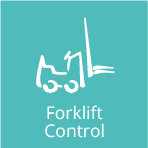ProStore®-Module Forklift Control

The ProStore® Forklift Control supports the use of mobile vehicles, such as forklifts or picking trucks, and ensures optimum control of the vehicles and routes. The Forklift Control System makes an important contribution to fast, error-free order processing and leads to an improved utilization of the vehicles.
Optimized ways and orders
Functional overview Forklift Control
-
- Definition of stacker areas / work areas (e.g., warehousing, relocation, picking, outsourcing, inventory, …).
- Assignment of vehicles and hand tools to work areas
- Definition of characteristics of the vehicles (e.g., lifting height, lifting weight, free-standing, gripping height for picking vehicles)
- These restrictions are taken into account when awarding transport orders.
- Generation of transport and picking orders as well as their processing taking account of the vehicle properties.
- Optimization of transport orders (double games, route optimization, …)
- Monitoring the transports
- A background process ensures that the priority of neglected transports is continuously increased.
(Single-stage, broken / multi-stage, variants depending on the work process, priorities, alternative routes, vehicle types). - General storage tasks such as adhoc rearrangements, quantity splits, repackaging, etc.
- Information about the contents of storage places and warehouses.
- Carrying out of inventories
Fork Lift Control System at Wilms
Functional Overview Transport Order Management
- In ProStore® the permissible material flow movements are defined in the form of transport paths. The header information defines the main path, i.e., the path from the source to the final destination, the positional information defining the partial paths to the final destination. For a main route, different sub-routes can be defined by grouping.
- Various parameters are stored on the transport routes, which, among other things, control whether the system specifies the transport request for this route (for example, outsourcing a pallet from a structured storage location to the goods issue), or the employee can select the pallet, Eg disposal of the goods entrance area).
- Transport orders are assigned a priority, which controls the processing sequence of the transports. The default priority of a transport is specified using master data; But it can also be changed by the operator in a corresponding dialog.
- The distance between I points can optionally be stored in order to make the assignment of the next transport order to the stacker area location-dependent. In this case, a background process ensures that the priority of neglected transports is continuously increased.




